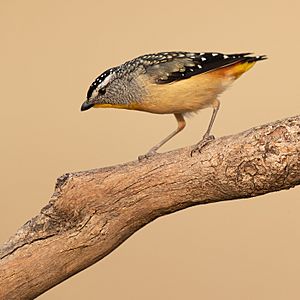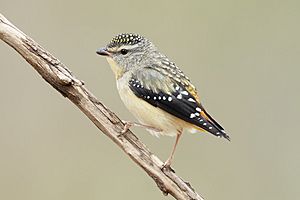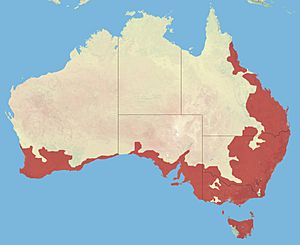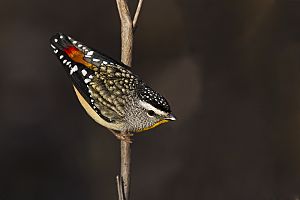Spotted pardalote facts for kids
Quick facts for kids Spotted pardalote |
|
|---|---|
 |
|
| Male, New South Wales | |
 |
|
| Female, New South Wales | |
| Conservation status | |
| Scientific classification | |
| Genus: |
Pardalotus
|
| Species: |
punctatus
|
 |
|
| Approximate distribution | |
The spotted pardalote (Pardalotus punctatus) is one of Australia's smallest and most colorful birds. It is only about 8 to 10 centimeters long. People sometimes call it the "diamondbird" because of its pretty spots.
You can find these birds in many fertile parts of Australia, like the east coast and the south-west. Even though they are common, they can be hard to spot up close.
There are three main types, or subspecies, of the spotted pardalote:
- The wet tropics spotted pardalote (militaris) lives in northeastern Queensland.
- The yellow-rumped pardalote (xanthopyge) lives in drier areas of southern Australia, especially in Mallee woodlands.
- The main type (punctatus) is found in southeastern Australia and Tasmania.
Contents
About the Spotted Pardalote
The spotted pardalote was first described in 1792 by George Shaw and Frederick Polydore Nodder. Early settlers in Australia called it the "Diamond Bird" because of its spotted feathers. Other old names include "diamond sparrow" and "bank diamond."
Indigenous people in Western Australia had names for it too, like widopwidop. Sometimes, people call it the "headache bird" because of its repeated "sleep-may-be" call during breeding season.
The name "pardalote" comes from the Greek word pardalotos, which means "spotted."
What Spotted Pardalotes Look Like
A spotted pardalote weighs about 6 grams and is 8 to 10 centimeters long.
- Males of the main type have grey-brown backs with light buff spots. Their head, wings, and tail are black with white spots. They have white eyebrows and a reddish rump. Their chest is pale, turning yellow at the throat.
- Females are a bit duller in color than the males.
The yellow-rumped type is a bit bigger. Its male has fine white spots on its back, a bright yellow rump, and a cream-colored chest. The wet tropics type is smaller and has a reddish rump.
Where Spotted Pardalotes Live
Spotted pardalotes live in many parts of Australia. They prefer areas with trees and shrubs. While their numbers seem to be going down in cities, they are not currently considered an endangered species.
Nesting and Reproduction
Spotted pardalotes usually breed from August or September to December or January. They start earlier in the northern parts of Australia and later in the south.
They build their nests underground. They dig a tunnel about 0.5 to 1.5 meters long into a riverbank or a shaded slope. At the end of the tunnel, they create an oval-shaped chamber. This chamber is lined with soft bark. It is usually higher than the entrance tunnel to keep it safe from floods. Sometimes, they even nest in unusual places like carpet rolls!
Pairs usually breed once a year. A female lays 3 to 4 shiny white eggs. The eggs are about 16 mm long and 13 mm wide. The parents sit on the eggs for 19 days until they hatch. The baby birds stay in the nest for another 21 days after hatching.
Spotted pardalotes make soft, whistling calls to each other all day. These calls can travel quite far. It can be tricky to find them because their contact call is actually two calls: an initial sound and an almost instant reply. These can come from different directions!
Images for kids
-
Female with nesting material (Risdon Brook, Tasmania, Australia)
See also
 In Spanish: Pardalote moteado para niños
In Spanish: Pardalote moteado para niños




